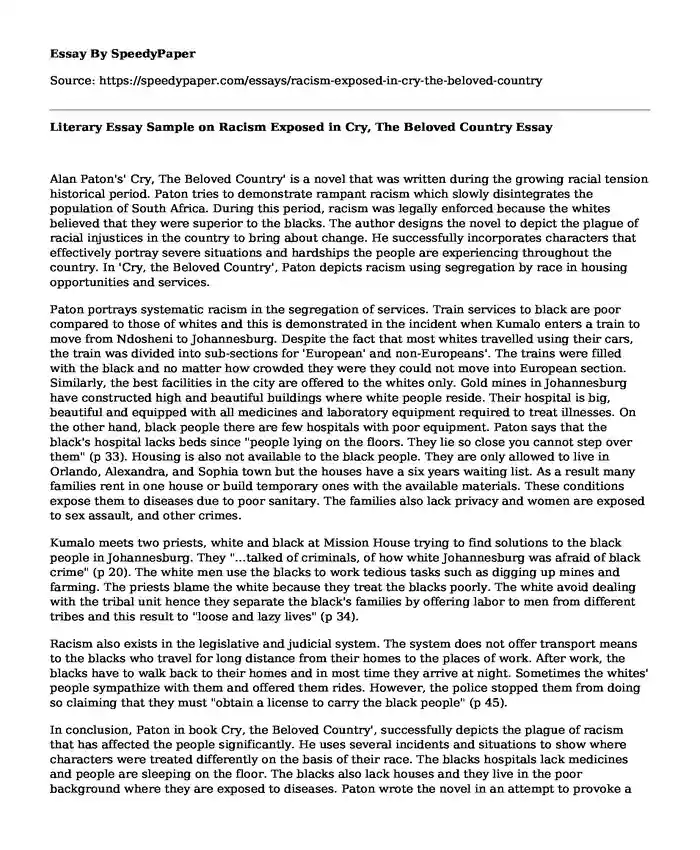
| Type of paper: | Essay |
| Categories: | American literature |
| Pages: | 3 |
| Wordcount: | 639 words |
Alan Paton's' Cry, The Beloved Country' is a novel that was written during the growing racial tension historical period. Paton tries to demonstrate rampant racism which slowly disintegrates the population of South Africa. During this period, racism was legally enforced because the whites believed that they were superior to the blacks. The author designs the novel to depict the plague of racial injustices in the country to bring about change. He successfully incorporates characters that effectively portray severe situations and hardships the people are experiencing throughout the country. In 'Cry, the Beloved Country', Paton depicts racism using segregation by race in housing opportunities and services.
Paton portrays systematic racism in the segregation of services. Train services to black are poor compared to those of whites and this is demonstrated in the incident when Kumalo enters a train to move from Ndosheni to Johannesburg. Despite the fact that most whites travelled using their cars, the train was divided into sub-sections for 'European' and non-Europeans'. The trains were filled with the black and no matter how crowded they were they could not move into European section. Similarly, the best facilities in the city are offered to the whites only. Gold mines in Johannesburg have constructed high and beautiful buildings where white people reside. Their hospital is big, beautiful and equipped with all medicines and laboratory equipment required to treat illnesses. On the other hand, black people there are few hospitals with poor equipment. Paton says that the black's hospital lacks beds since "people lying on the floors. They lie so close you cannot step over them" (p 33). Housing is also not available to the black people. They are only allowed to live in Orlando, Alexandra, and Sophia town but the houses have a six years waiting list. As a result many families rent in one house or build temporary ones with the available materials. These conditions expose them to diseases due to poor sanitary. The families also lack privacy and women are exposed to sex assault, and other crimes.
Kumalo meets two priests, white and black at Mission House trying to find solutions to the black people in Johannesburg. They "...talked of criminals, of how white Johannesburg was afraid of black crime" (p 20). The white men use the blacks to work tedious tasks such as digging up mines and farming. The priests blame the white because they treat the blacks poorly. The white avoid dealing with the tribal unit hence they separate the black's families by offering labor to men from different tribes and this result to "loose and lazy lives" (p 34).
Racism also exists in the legislative and judicial system. The system does not offer transport means to the blacks who travel for long distance from their homes to the places of work. After work, the blacks have to walk back to their homes and in most time they arrive at night. Sometimes the whites' people sympathize with them and offered them rides. However, the police stopped them from doing so claiming that they must "obtain a license to carry the black people" (p 45).
In conclusion, Paton in book Cry, the Beloved Country', successfully depicts the plague of racism that has affected the people significantly. He uses several incidents and situations to show where characters were treated differently on the basis of their race. The blacks hospitals lack medicines and people are sleeping on the floor. The blacks also lack houses and they live in the poor background where they are exposed to diseases. Paton wrote the novel in an attempt to provoke a change in these deteriorating conditions in South Africa. Every race is important and none is superior to the other and therefore people should live in harmony for the unity and development of the country.
Works Cited
Paton, Alan. Cry, the beloved country. Simon and Schuster, 2003.
Cite this page
Literary Essay Sample on Racism Exposed in Cry, The Beloved Country. (2022, Jun 09). Retrieved from https://speedypaper.com/essays/racism-exposed-in-cry-the-beloved-country
Request Removal
If you are the original author of this essay and no longer wish to have it published on the SpeedyPaper website, please click below to request its removal:
- Disappointing Experience Essay: Features and Specifications of the Paper
- Reflection Paper Sample about Nurses Professional Development
- Free Essay with a Case: New York Times V. United States
- Project Management Essay: Scope Compliance and Ethics
- Free Essay Sample on Drug Enforcement Administration
- Free Essay Comprising the Full Script Analysis of Cloud 9 by Carl Churchill
- Free Essay Example. Gerontological Vulnerability
Popular categories




